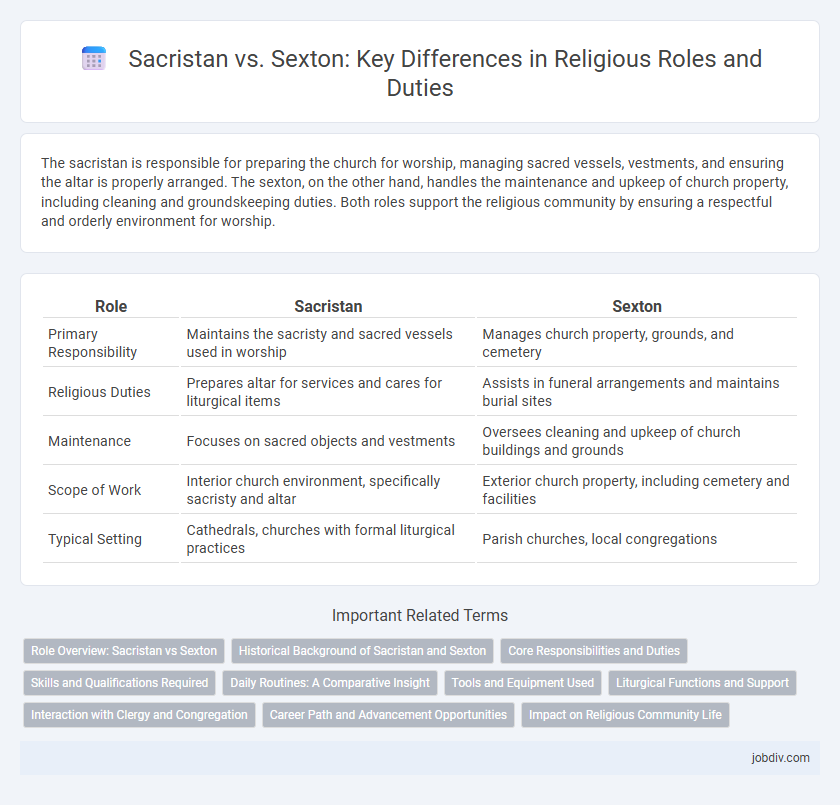The sacristan is responsible for preparing the church for worship, managing sacred vessels, vestments, and ensuring the altar is properly arranged. The sexton, on the other hand, handles the maintenance and upkeep of church property, including cleaning and groundskeeping duties. Both roles support the religious community by ensuring a respectful and orderly environment for worship.
Table of Comparison
| Role | Sacristan | Sexton |
|---|---|---|
| Primary Responsibility | Maintains the sacristy and sacred vessels used in worship | Manages church property, grounds, and cemetery |
| Religious Duties | Prepares altar for services and cares for liturgical items | Assists in funeral arrangements and maintains burial sites |
| Maintenance | Focuses on sacred objects and vestments | Oversees cleaning and upkeep of church buildings and grounds |
| Scope of Work | Interior church environment, specifically sacristy and altar | Exterior church property, including cemetery and facilities |
| Typical Setting | Cathedrals, churches with formal liturgical practices | Parish churches, local congregations |
Role Overview: Sacristan vs Sexton
The sacristan is primarily responsible for preparing the sacristy, ensuring that liturgical items such as vestments, chalices, and altar linens are clean and ready for worship services. The sexton oversees the maintenance and upkeep of the church property, including groundskeeping, security, and opening or closing the building for events. Both roles support the smooth operation of religious services but focus on distinctly different aspects: sacristan on liturgical preparation and sexton on facility management.
Historical Background of Sacristan and Sexton
The sacristan historically managed the sacristy, overseeing sacred vessels, vestments, and church preparations dating back to early Christian worship practices. The sexton, with origins in medieval Europe, primarily handled church maintenance, graveyard duties, and bell ringing, serving both practical and ceremonial roles. Both roles evolved to support liturgical functions, reflecting the organizational needs of their respective religious communities over centuries.
Core Responsibilities and Duties
A Sacristan is primarily responsible for maintaining the sacristy, preparing liturgical items such as chalices, vestments, and altar linens, and ensuring the church is ready for worship services and ceremonies. The Sexton's duties focus on the upkeep of church property, including cleaning, maintenance, and managing the church grounds and buildings. Both roles support the smooth operation of religious services but differ in their emphasis on liturgical preparation versus facility management.
Skills and Qualifications Required
Sacristans require meticulous attention to detail and knowledge of liturgical practices to prepare sacred vessels and maintain altar linens, often possessing skills in organization and basic ceremonial protocol. Sextons need expertise in physical maintenance, groundskeeping, and building security, along with qualifications in custodial management and sometimes minor repair work. Both roles demand a deep understanding of religious customs and a strong commitment to supporting clergy and congregation through their specialized duties.
Daily Routines: A Comparative Insight
Sacristans manage the preparation and care of the church's liturgical items, ensuring chalices, vestments, and altar linens are ready for daily services. Sextons handle the maintenance of church grounds and buildings, including opening and closing the church, overseeing heating, cleaning, and minor repairs. This distinction highlights sacristans' focus on service readiness, while sextons prioritize facility upkeep and security in daily routines.
Tools and Equipment Used
Sacristans primarily use liturgical tools such as chalices, patens, altar linens, and sacred vessels to prepare the altar and maintain the sanctity of the worship space. Sextons handle more practical equipment like keys, brooms, mops, and maintenance tools to manage the church's physical upkeep and security. Both roles require specialized equipment tailored to their distinct responsibilities within religious settings.
Liturgical Functions and Support
Sacristans manage the preparation and care of liturgical items such as vestments, chalices, and altar linens, ensuring all materials are ready for worship services. Sextons maintain the church building and grounds, often overseeing tasks like bell ringing, graveyard upkeep, and facility security to support the liturgical environment. Both roles are essential for the smooth execution of religious ceremonies, with sacristans focusing on ritual elements and sextons on the physical space.
Interaction with Clergy and Congregation
Sacristans primarily support clergy by preparing liturgical items and maintaining the sacristy, ensuring smooth worship services and assisting priests directly. Sextons manage the church property and often serve as custodians, facilitating interactions with the congregation by maintaining the church environment and assisting visitors. Both roles are essential for harmonious church operations, with sacristans focusing on sacred preparations and sextons on facility upkeep and community engagement.
Career Path and Advancement Opportunities
A sacristan typically manages the care of sacred vessels, linens, and liturgical spaces, often starting in entry-level church service roles with opportunities to advance into parish administration or worship coordination. Sextons focus on the maintenance and security of church buildings and grounds, which can lead to supervisory positions in facilities management or cemetery operations within religious institutions. Both roles offer unique career paths, with sacristans leaning towards liturgical support and sextons toward property stewardship, allowing for advancement aligned with specialized skills and church needs.
Impact on Religious Community Life
Sacristans maintain sacred vessels, vestments, and the preparation of liturgical spaces, ensuring the smooth conduct of religious rituals that reinforce communal worship and spiritual discipline. Sextons manage church property, grounds, and security, fostering a safe and welcoming environment that supports community gatherings and outreach activities. Both roles are essential for sustaining the religious community's operational integrity and enhancing collective spiritual experiences.
Sacristan vs Sexton Infographic

 jobdiv.com
jobdiv.com